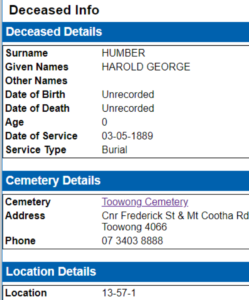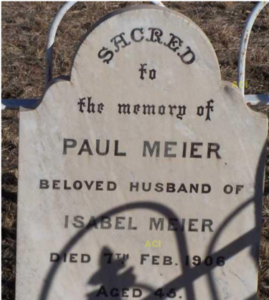Grave and Memorial Location Search
Following your ancestor from cradle to grave inevitably ends in the search for their last resting place. Cemeteries also have stories to tell family historians.
Visiting the grave or memorial of an ancestor you have spent days, or even years, researching can be an emotional experience. Historical cemeteries such as Toowong, South Brisbane and Lutwyche are quite large and, in the case of Toowong, very hilly! Don’t go on a hot day without a plan. I went with a plan, and water, but it was still an exhausting outing.
Locating the grave hopefully leads to a headstone or plaque where, cross fingers, someone has kindly drawn up the family tree. Failing that, finding out who else is buried in the grave can lead to some interesting insights into family relationships.
In South East Queensland, local authorities provide excellent resources for locating graves and memorials. Before you grab your hat and pop on the walking shoes, check out the many grave and memorial indexes that are available online.
The Brisbane City Council Gravel Location Tool searches 12 cemeteries and crematoria. There are hints and tips for searching and a full list of the locations. There are also links to many private cemeteries and crematoria.
To begin searching select the search tool button. At the top of the screen will be a search box.
 You don’t need a date, or even a given name but if the surname is common then of course that helps. It’s often interesting just to look at the surname. The family’s resting places may be spread over a number of locations. This can indicate different places of residence over time. For my example I searched for surname HUMBER. Ten HUMBERS appeared and well as HUMBERDROSS etc. This could help with misspelled surnames as well.
You don’t need a date, or even a given name but if the surname is common then of course that helps. It’s often interesting just to look at the surname. The family’s resting places may be spread over a number of locations. This can indicate different places of residence over time. For my example I searched for surname HUMBER. Ten HUMBERS appeared and well as HUMBERDROSS etc. This could help with misspelled surnames as well.
I was looking for Harold George HUMBER so I selected Details.
In this case some of the details were missing, but I have seen some quite interesting information in this section.
The location in Toowong cemetery is given as a code. On the grave location search page there are links to cemetery maps so you can find the exact place.
But it’s the Other Deceased section which is the most interesting.
 These are all burials in the same plot! Untangling the family relationships can reveal more clues for your research. Beware, however, that plots could be reused. I once spent a fascinating morning with a GSQ member chasing up a spurious man’s name we found in a woman’s grave. Our vivid imaginations led us on a wild chase which turned out to have that very boring result – not related.
These are all burials in the same plot! Untangling the family relationships can reveal more clues for your research. Beware, however, that plots could be reused. I once spent a fascinating morning with a GSQ member chasing up a spurious man’s name we found in a woman’s grave. Our vivid imaginations led us on a wild chase which turned out to have that very boring result – not related.
Paddington Cemetery operated from 1844 to 1875. Around 1911 186 people and 136 memorials were removed to Toowong. Plans of the cemetery, lists of removals and other work carried out can be found on the website.
Find a Grave is another quick way to search a cemetery without leaving home. If you know the general location use the Cemetery Location Browse button to narrow the search. For example, I selected Australia, Queensland, East Brisbane. There was one result – St Paul Anglican Columbarium, 554 Vulture Street, East Brisbane.
There are 247 added and 100% photographed. Selecting the 247 added gave an alphabetical list along with photographs. No need to even get out of your chair. International cemeteries can be searched from here. Not all have been photographed.
Australian Cemeteries Index can be searched by name or cemetery. For example, Amby, a small place in Queensland, lists all photographed memorials including that of my husband’s ancestor, Paul Meier.
 Another site of interest is Nudgee Cemetery which includes Nudgee Cemetery, Nudgee Crematorium, St Therese & St Anthony Kedron and Our Lady, Queen of Apostles Stafford. It doesn’t show other burials in the plot but it does give a map location and you can search all of a particular surname with burials as recent as this year.
Another site of interest is Nudgee Cemetery which includes Nudgee Cemetery, Nudgee Crematorium, St Therese & St Anthony Kedron and Our Lady, Queen of Apostles Stafford. It doesn’t show other burials in the plot but it does give a map location and you can search all of a particular surname with burials as recent as this year.
For Mt Thompson it’s best to scroll down to Finding Loved Ones Resting Place by HeavenAddress where you can search by name. Searching for Merkley gave me five names along with photographs of the memorial plaques.
Eight cemeteries belonging to the Moreton Bay Regional Council can be searched. Looking for Austins gave long list. Fanny Austin at Lawnton cemetery gives a transcription of the memorial and there’s a link to a photograph.
Logan City works a little differently. Each of the council owned cemeteries has a downloadable map and index. The private cemeteries, just the index.
Ipswich disappointingly has links to its cemeteries but there is only general information and no online search. From the web site – Ipswich Cemeteries staff can provide assistance with the location and details of family burials. A fee of $25.00 for up to six names applies.
If you are searching other places in Queensland or Australia, try the Regional Council sites. The State Library Queensland has an excellent guide to cemetery records as well.
While there is something rewarding about tramping around cemeteries finding ancestors, being able to narrow the search, read tombstones and plaques without getting sweaty is always a positive for me.
Happy Hunting.

Thank you Sharyn, I followed your helpful steps and found more information about a family baby – she lived for 1 hour, and although her date of birth or death are not recorded, the Date of Service fits within the gap between surviving siblings. She had at least 2 stillborn brothers who are not listed although the family gave them names. They likely died before the family moved to Brisbane, so I will have to access the other cemetery listing.